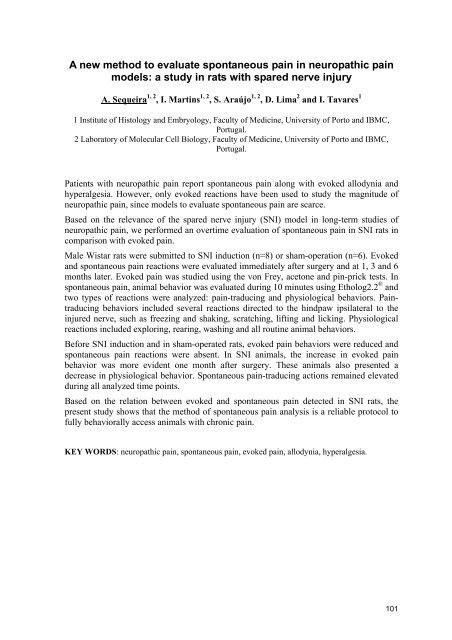IJUP08 - Universidade do Porto
IJUP08 - Universidade do Porto
IJUP08 - Universidade do Porto
- TAGS
- universidade
- porto
- ijup.up.pt
Create successful ePaper yourself
Turn your PDF publications into a flip-book with our unique Google optimized e-Paper software.
A new method to evaluate spontaneous pain in neuropathic pain<br />
models: a study in rats with spared nerve injury<br />
A. Sequeira 1, 2 , I. Martins 1, 2 , S. Araújo 1, 2 , D. Lima 2 and I. Tavares 1<br />
1 Institute of Histology and Embryology, Faculty of Medicine, University of <strong>Porto</strong> and IBMC,<br />
Portugal.<br />
2 Laboratory of Molecular Cell Biology, Faculty of Medicine, University of <strong>Porto</strong> and IBMC,<br />
Portugal.<br />
Patients with neuropathic pain report spontaneous pain along with evoked allodynia and<br />
hyperalgesia. However, only evoked reactions have been used to study the magnitude of<br />
neuropathic pain, since models to evaluate spontaneous pain are scarce.<br />
Based on the relevance of the spared nerve injury (SNI) model in long-term studies of<br />
neuropathic pain, we performed an overtime evaluation of spontaneous pain in SNI rats in<br />
comparison with evoked pain.<br />
Male Wistar rats were submitted to SNI induction (n=8) or sham-operation (n=6). Evoked<br />
and spontaneous pain reactions were evaluated immediately after surgery and at 1, 3 and 6<br />
months later. Evoked pain was studied using the von Frey, acetone and pin-prick tests. In<br />
spontaneous pain, animal behavior was evaluated during 10 minutes using Etholog2.2 ® and<br />
two types of reactions were analyzed: pain-traducing and physiological behaviors. Paintraducing<br />
behaviors included several reactions directed to the hindpaw ipsilateral to the<br />
injured nerve, such as freezing and shaking, scratching, lifting and licking. Physiological<br />
reactions included exploring, rearing, washing and all routine animal behaviors.<br />
Before SNI induction and in sham-operated rats, evoked pain behaviors were reduced and<br />
spontaneous pain reactions were absent. In SNI animals, the increase in evoked pain<br />
behavior was more evident one month after surgery. These animals also presented a<br />
decrease in physiological behavior. Spontaneous pain-traducing actions remained elevated<br />
during all analyzed time points.<br />
Based on the relation between evoked and spontaneous pain detected in SNI rats, the<br />
present study shows that the method of spontaneous pain analysis is a reliable protocol to<br />
fully behaviorally access animals with chronic pain.<br />
KEY WORDS: neuropathic pain, spontaneous pain, evoked pain, allodynia, hyperalgesia.<br />
101










